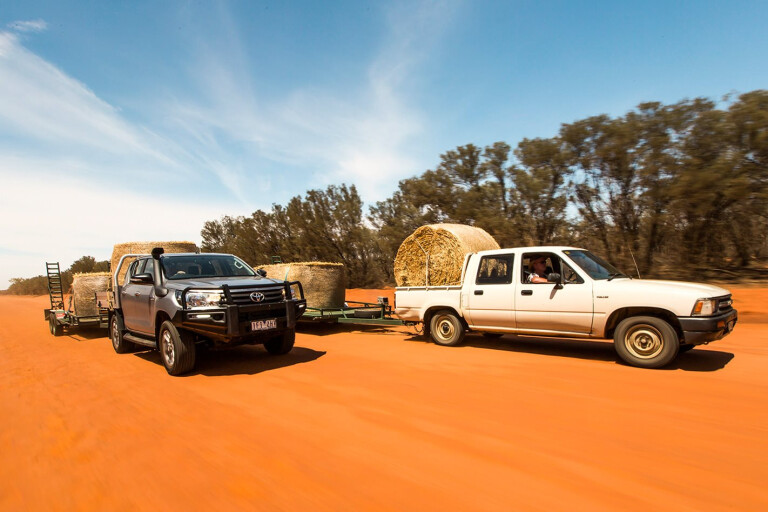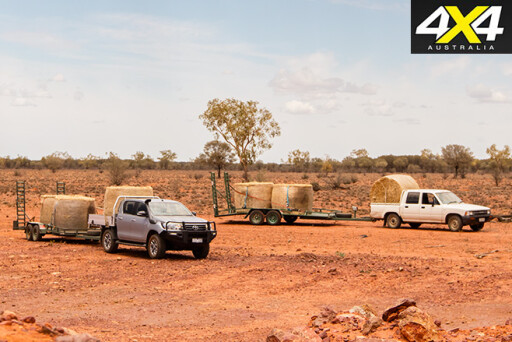
At a servo in Deniliquin the young lady behind the counter passed her dubious gaze over the two Toyotas sitting at the pumps: one a shiny new HiLux SR 4x4; the other a well-used and abused ’89 4x2 HiLux.
“So where are you headed?” She asked as I paid for the fuel. “Quilpie in Western Queensland,” I replied.
She looked at me wide-eyed: “Quilpie? I once stayed there for three days and just cried the whole time it was so hot!” I nodded sympathetically.
She continued: “Do you know they even have to keep chocolate biscuits in the fridge out there?”
 The drought and subsequent rains recently in Western Queensland have been in the news quite a bit of late, as more than 80 per cent of the state has squirmed in the parched grip of a drought that is well into its fourth year.
The drought and subsequent rains recently in Western Queensland have been in the news quite a bit of late, as more than 80 per cent of the state has squirmed in the parched grip of a drought that is well into its fourth year.
In fact, some parts of the state have been dry for nearly five years. Many were even calling this drought the worst in living memory.
We thought we’d take the new Toyota HiLux 4x4 for a long-haul test drive with tandem trailer and a tonne of hay on board to see how the new banger handles a load and a long drive. And to make it a little more interesting we also took my own 25-year-old, 2.4-litre petrol HiLux along to see if that old unbreakable tagline still rings true.
 Brian Egan runs the bush charity Aussie Helpers and has been working seven days a week to keep assistance flowing out to where the rivers and creeks run dry. The Aussie Helpers team clocked up more than 500,000km and helped more than 1100 people during 2015.
Brian Egan runs the bush charity Aussie Helpers and has been working seven days a week to keep assistance flowing out to where the rivers and creeks run dry. The Aussie Helpers team clocked up more than 500,000km and helped more than 1100 people during 2015.
We caught up with Brian on a pre-Christmas hamper run to some properties in the Quilpie and Adavale areas to see the severity of the drought first-hand.
As we headed towards the Victorian border I was again a little worried that I may have been asking a bit much of the old-banger. A headwind saw me stuck in fourth gear at about 80 clicks, while a thunderstorm saw me back to third as I peered through the unrelenting rain.
With one-tonne of hay on board and nearly a tonne of tandem trailer behind, the old HiLux was pretty much at maximum legal payload.
 The new SR’s 2.8-litre powerplant was just idling along with the same load. The trend towards taller gearing in virtually all new vehicles meant the new HiLux rarely spent any time in sixth gear when loaded, but even in fifth the tacho needle was below 2000rpm when cruising at the speed limit.
The new SR’s 2.8-litre powerplant was just idling along with the same load. The trend towards taller gearing in virtually all new vehicles meant the new HiLux rarely spent any time in sixth gear when loaded, but even in fifth the tacho needle was below 2000rpm when cruising at the speed limit.
The mercury stayed in the high 30s as we headed through Cobar and on to Bourke. Steve had his stint behind the wheel of the old dual-cab, while I took advantage of the air-con in the new beast. Road speed was pretty much determined by the temperature gauge of the old ute; however, it just plugged away and only needed to stop in the shade to cool off on a couple of occasions.
 The ever-changing landscape scrolled past our windows: scrub and feral goats between Cobar and Bourke; the startling burst of greenery of the river flood plains at the Queensland border; the dry open country out to Cunnamulla; and the bush surrounding Charleville. But the red rock and scrub that flanks the Diamantina Development Road, as it stretches west toward Quilpie and beyond, highlighted the harsh realities of farming in the outback. It’s an unforgiving landscape.
The ever-changing landscape scrolled past our windows: scrub and feral goats between Cobar and Bourke; the startling burst of greenery of the river flood plains at the Queensland border; the dry open country out to Cunnamulla; and the bush surrounding Charleville. But the red rock and scrub that flanks the Diamantina Development Road, as it stretches west toward Quilpie and beyond, highlighted the harsh realities of farming in the outback. It’s an unforgiving landscape.
We rolled to a stop at the turn-off to the remote hamlet of Adavale (population 20). Brian was already waiting for us in his tinsel-covered LandCruiser, eager to get going and deliver some Christmas cheer.
 Brian and his wife Nerida started Aussie Helpers more than 13 years ago after Brian – a Navy veteran-cum-farmer – was hospitalised with depression and post-traumatic stress disorder.
Brian and his wife Nerida started Aussie Helpers more than 13 years ago after Brian – a Navy veteran-cum-farmer – was hospitalised with depression and post-traumatic stress disorder.
Brian and Nerida lost their own farm on the Darling Downs due to drought. During his recovery, a counsellor suggested Brian should find someone worse off than himself and help them and it was this suggestion that saw the birth of Aussie Helpers. From humble country pub hamper raffles to thrift shops, the organisation has grown to run a modest fleet of vehicles distributing everything – from toiletries and food, to hay – to those in need in the bush.
With Brian leading the way we set off up the 125km dirt road that led to Adavale. It soon had me thinking that maybe I really was going to kill the old ute. With the exception of a couple of optimistic stretches of asphalt, it was like an endless cattle grid that had my teeth jumping in my head.
 I was sure something important, like maybe the gearbox, was going to fall out. Yet with a bit of care it continued to chug along. I quickly became coated in a film of red dust while clanging along in the old girl.
I was sure something important, like maybe the gearbox, was going to fall out. Yet with a bit of care it continued to chug along. I quickly became coated in a film of red dust while clanging along in the old girl.
North of Adavale we popped in to see Debbie and Ben Pegler at their 769km² property. The Peglers had been weathering the dry stoically, putting out licks and holding on to their 900-head breeding herd. This area has the advantage of artesian water, so Debbie keeps the garden around the house lush. “It just makes you feel better to look out the window and see some green,” she said. Son Darcy was helping sand floorboards upstairs in the absence of any stockwork to do.
 This area had about three inches of rain just over six months ago, then quite a bit more over the new-year period. But with follow-up rain, cattle can walk themselves to death trying to eat enough of the modest green pick that emerges. Energy expended versus energy consumed.
This area had about three inches of rain just over six months ago, then quite a bit more over the new-year period. But with follow-up rain, cattle can walk themselves to death trying to eat enough of the modest green pick that emerges. Energy expended versus energy consumed.
We dropped some more hay at Leopardwood Park, which is owned by Vin and Jenny Richardson. Like many of the stations in this area, Leopardwood Park was historically a sheep property, though cattle mainly dominate now when times are good. The 312km² station is relatively modest in size by local standards.
Leopardwood is now pretty much destocked while the family contracts with the local shire, carrying out road maintenance with their own heavy machinery. This sees the family away from home quite a bit while earning a crust. Again, sulphurous sub-artesian ground water keeps the house block cheerfully green – an unlikely green dot on an otherwise parched red-and-brown-patchwork landscape.
 Our last stop was the historic Milo station Established in the 19th century, Milo was a massive sheep property well into the 20th century. The beautiful homestead is surrounded by outbuildings buckling in the fierce heat.
Our last stop was the historic Milo station Established in the 19th century, Milo was a massive sheep property well into the 20th century. The beautiful homestead is surrounded by outbuildings buckling in the fierce heat.
Nobody was home, so Brian unloaded his cargo of hampers and left them for the family to find when they return. Steve and I kicked off the last bales of hay and listened to the old HiLux almost sigh with relief as it slowly sprung back up on its suspension.
It was a hell of a journey: desiccated road kill baking in the sun; big trucks thundering out of the heat haze on lonely highways; slat-sided, hollow-eyed cattle regarding our progress with bovine indifference; and stoic country dwellers reluctant to complain too much about their circumstances, instead riding out the storm and searching an empty horizon for rain clouds.
 And maybe I’m just starting to get the whole Toyota thing. My old farm hack gamely chugged from Melbourne to Western Queensland and back to Brisbane – a 3000km round trip – without even a hiccup. I found myself getting strangely attached to the ugly old bucket.
And maybe I’m just starting to get the whole Toyota thing. My old farm hack gamely chugged from Melbourne to Western Queensland and back to Brisbane – a 3000km round trip – without even a hiccup. I found myself getting strangely attached to the ugly old bucket.
The new HiLux seems a worthy successor, though. Some may say it’s gone a little soft in an effort to compete with other offerings on the market, but after spending many hours behind the wheel of the new jigger, both loaded and unloaded on a variety of road surfaces, my initial impressions haven’t changed. It’s quiet and comfortable with long highway legs for a big country, yet it retains that uniquely Toyota kind of pragmatic charm.
Checkout Aussie Helpers to see how you can contribute to making life on the land a bit easier during these dry times.

COMMENTS